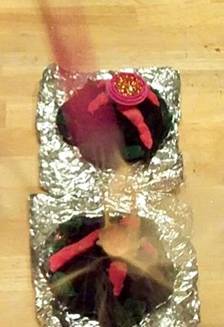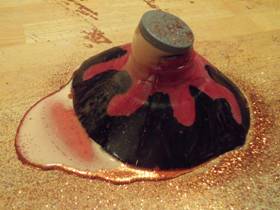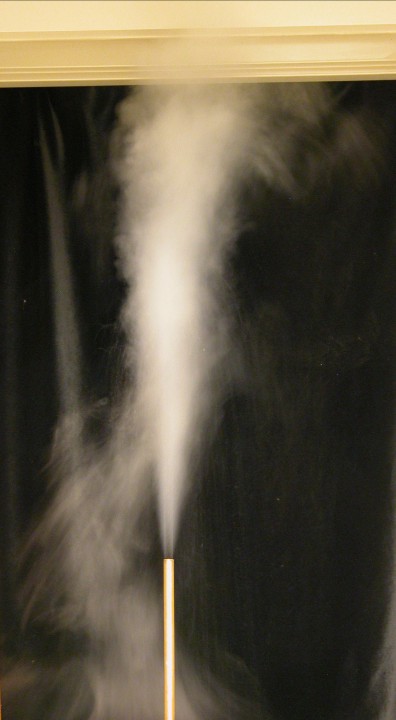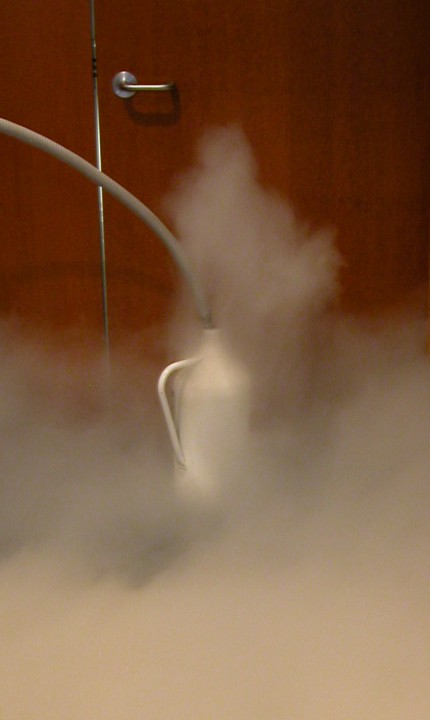Sunday, July 22, 2012
Bubble Snouts
OK, not sure this is a demo so much as just a cool thing to do with bubbles. Simply use a rubber band to stretch terrycloth fabric over the wide part of a funnel made from the top of a 1 liter soda bottle. Dip the fabric into bubble solution and blow into the narrow part of the funnel (do not inhale!). The air pushes through the terrycloth to produce a stream or snout of many small bubbles.
Saturday, July 21, 2012
Geology Demo - Seltzer Popper Volcanoes
These demonstrations are a twist on the classic homemade volcano, in which vinegar and baking soda chemically react in a model of a volcano to produce sodium acetate, water, and carbon dioxide gas. The carbon dioxide bubbles up out of the model to produce bubbling “lava” which oozes out of the “volcano”. The picture below shows the same reaction in a soda bottle (food coloring and dish soap have been added to make the lava flow more impressive).


But what about the volcanoes with more explosive eruptions? Here we adapt another classic demonstration involving film canisters and Alka-Seltzer tablets. Wear eye protection. First lay down a sheet of plastic to make cleanup easier. Place a film canister into a clay volcano, setting the lid aside for now. Fill a milk cap with glitter. Fill the film canister halfway with water, with maybe a little dish soap and red and yellow food coloring for a “lava” effect. Break a tablet of Alka-Seltzer in half (any more that is wasted). Make sure everything is ready and the area is cleared out around the volcano.

Then, QUICKLY add the half-tablet of Alka-Seltzer to the film canister, cover the canister tightly with the lid, place the milk cap full of glitter on top of the lid, and take a step back (NEVER stand over the lid). The citric acid and baking soda in the tablet dissolve in the water and chemically react to produce sodium citrate, water, and carbon dioxide gas. The gas pressure builds up in the capped film canister until the lid pops off, scattering the glitter and sending reddish suds oozing down the side of the volcano.

Then, QUICKLY add the half-tablet of Alka-Seltzer to the film canister, cover the canister tightly with the lid, place the milk cap full of glitter on top of the lid, and take a step back (NEVER stand over the lid). The citric acid and baking soda in the tablet dissolve in the water and chemically react to produce sodium citrate, water, and carbon dioxide gas. The gas pressure builds up in the capped film canister until the lid pops off, scattering the glitter and sending reddish suds oozing down the side of the volcano.


We can also use the Alka-Seltzer tablets to illustrate the effects that size has on processes. If the half-tablet that is added to the film canister is first broken into small pieces, it will dissolve much more quickly in water to react and produce carbon dioxide gas. The result is that, with all else equal, a popper volcano with the broken-up half-tablet will pop more quickly after loading than one with an intact half-tablet. This illustrates how processes can proceed more quickly at smaller scales. For example, many people are studying how making things really small (at the nanoscale) with lots of surface area can speed up chemical reactions.
Another note: We have also noticed that a film canister fits into the top of a milk jug with just a little widening (we also colored the jug piece with permanent markers). This seems to be very inexpensive way to make a waterproof volcano cone without having to use modeling clay.

Friday, July 20, 2012
Geology Demo - Liquid Nitrogen Base Surge and Downburst
CAUTION: Liquid nitrogen is very cold and presents a serious frostbite
hazard, especially if it gets trapped against your skin (e.g.in your clothing).
Additionally, gaseous nitrogen occupies more volume than the same quantity of
liquid nitrogen. Gaseous nitrogen produced quickly enough in sufficient
quantities can displace oxygen from the air. Containers filled with liquid
nitrogen could fail without warning due to thermal shock or gas pressure.
Protect yourself accordingly.
Base surges and downbursts occur when dense gases sink rapidly down through
less dense gases and spread outward upon impacting the ground. Base surges are
clouds of gas and dust that move along the ground away from a volcanic eruption
or a nuclear explosion. It is often produced when a column of these clouds
collapses to the ground. Downbursts, and smaller microbursts, occur when cold
air sinks to the ground from a thunderstorm. A similar phenomenon seems to occur
during the filling of a typical 4 liter Dewar flask with a relatively narrow
neck from a liquid nitrogen supply line. As the liquid nitrogen (boiling at 77
K) first passes through the supply line and into the flask at room temperature
(about 298 K), the liquid nitrogen flashes into pressurized vapor. The vapor
rushes out of the Dewar flask, creating a column of cool nitrogen vapor and
condensed water droplets. As the supply line cools, liquid nitrogen actually
makes it into the Dewar flask. The liquid nitrogen boils away less rapidly and
the pressure forcing the nitrogen vapor up from the Dewar flask decreases. The
cold dense vapor column then collapses down and spreads across the ground,
resembling a base surge or a downburst.
References:
Clark Johnson. Base Surge.
http://www.geology.wisc.edu/~g111/Terms/base_surge/base_surge.htm (accessed
June, 2006).
Denton County, Texas. Downbursts.
http://www.co.denton.tx.us/dept/main.asp?Parent=82&Link=84#Mistaken
(accessed June, 2006).
BELOW: A liquid nitrogen base surge: (FIRST) Formation of the column of cool
nitrogen vapor and condensed water and (MIDDLE) collapse of the column. (LAST) Surge of air moving out from a thunderstorm rain column near Carlsbad, NM, in June, 2012.
Friday, July 13, 2012
Geology Demo - Liquid Nitrogen Geyser
Liquid nitrogen geysers have been observed on Neptune's moon Triton (these are believed to erupt via a different mechanism than here on Earth). A small liquid nitrogen geyser can be made by placing a meter-long copper tube partially into a pool of liquid nitrogen. The tube at room temperature is inserted into the Dewar flask that contains some liquid nitrogen. Since the boiling point of liquid nitrogen is 77K and the tube is approximately room temperature (298 K), liquid nitrogen entering the tube will quickly vaporize, pushing vapor and liquid nitrogen up the tube into the air for a brief time.


Subscribe to:
Posts (Atom)

